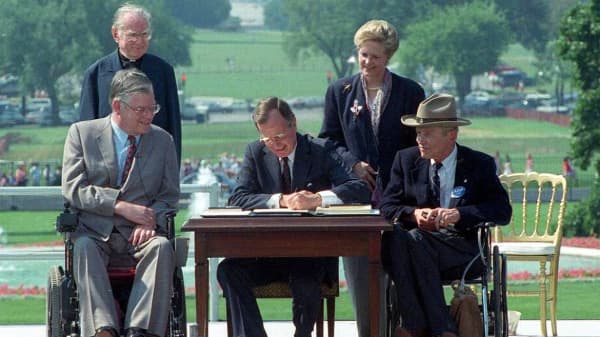
With the passing of the 41st president, it’s worth remembering what may be his signature achievement.
 |
Richard Slawsky is an Educator and freelance writer, specializing in the digital signage and kiosk industries.Louisville, Kentucky Area |
The death of former president George H.W. Bush Nov. 30 at age 94 prompted a host of reminiscing in the media. Bush’s passing, many wrote, was the end of an era where politicians acted like ladies and gentlemen, treating friend and foe alike with dignity and respect.
Much of it was revisionism, of course. Bush’s Willie Horton campaign ad in his 1988 battle with Michael Dukakis is still discussed in political science classes because of its racial overtones. Many of the tactics used in his 1992 campaign against Bill Clinton, buoyed by the spread of the Internet, set the stage for the dysfunction currently plaguing both media and government. And one might argue that the effects of Bush’s handling of the invasion of Iraq are still being felt today.
Still, Bush guided the country through perilous waters as the Berlin Wall fell and the Soviet Union collapsed. And if there was something alive during Bush’s time that seems to be gone today, it’s the ability to compromise; for opposing sides to come together and accomplish something for the greater good.
On July 26, 1990, Bush signed what’s been called the most sweeping civil rights legislation enacted since the 1960s: The Americans with Disabilities Act. The signing came just weeks after the bill sailed through Congress with overwhelming bipartisan support.
And while the effectiveness of the ADA remains a subject for debate, there’s no doubt about its impact on the kiosk industry, the country at large and most importantly, the lives of people with disabilities.
Long in the making
Although the ADA was codified into law during Bush’s tenure, it has its roots in the three pieces of major civil rights legislation passed in the 1960s: the Civil Rights Act of 1964, the Voting Rights Act of 1965 and the Civil Rights Act of 1968. According to the Mid-Atlantic ADA Center, the Civil Rights Act of 1964 covered employers, those receiving federal funds and places of public accommodation such as restaurants and bus stations, prohibiting discrimination on the basis of race, religion and national origin.
The Voting Rights Act of 1965 protects the voting rights of minorities, while the Civil Rights Act of 1968 prohibits discrimination on the basis of race, religion, national origin and sex in the sale and rental of housing.
None of that legislation, though, covered people with disabilities. It wasn’t until the next decade when the country saw significant movement on disability rights. Section 504 of the Rehabilitation Act of 1973 prohibited discrimination on the basis of disability in federal programs and by recipients of federal financial assistance. In 1975, the Education for All Handicapped Children Act mandated that public schools accepting federal funds provide equal access to education for children with physical and mental disabilities. The act was revised and renamed the Individuals with Disabilities Education Act in 1990.
Although the 70s-era legislation was a start, it was the ADA that addressed discrimination against people with disabilities in many employment situations and public accommodations in the private sector. The bill’s effect wasn’t confined to the United States. According to Patrisha Wright, co-founder of the Disability Rights Education and Defense Fund, the ADA served as the inspiration for the U.N. Convention on the Rights of Persons with Disabilities, and has prompted several other countries to pass similar legislation.
An unlikely champion
Although Bush championed the ADA’s passage, his support for disability rights legislation was something that few could have predicted. According to Lex Frieden, executive director of the National Council on the Handicapped, Bush had a major encounter with disability issues in the public sphere when then-President Ronald Reagan appointed him to oversee a task force that was working to weaken the Education for All Handicapped Children Act.
“Parents of kids with disabilities heard about that and began to call and write the White House and express their anger and angst to Vice President Bush,” Frieden told the Pacific Standard. “He was taken aback about that. He addressed his staff and told them back off [from gutting the EHCA].”
In addition, many in government were actively in favor of disability rights legislation, including then-Sen. Robert Dole of Kansas, who suffered wounds in World War II that left his right arm permanently disabled and his left arm minimally functional, and former White House Press Secretary James Brady, who was left partially paralyzed after being shot in March 1980 during John Hinckley’s assassination attempt on President Reagan. Sen. Tom Harkin of Iowa, whose brother was deaf, was the chief sponsor of the ADA in the Senate.
“It’s been the work of a true coalition, a strong and inspiring coalition of people who have shared both a dream and a passionate determination to make that dream come true,” Bush said at the signing, according to the. “It’s been a coalition in the finest spirit—a joining of Democrats and Republicans, of the legislative and the executive branches, of federal and state agencies, of public officials and private citizens, of people with disabilities and without.”
Much left to be done
The ADA has remained controversial since its passage, garnering criticism for the barrage of lawsuits it has prompted over the years.
At the same time, much of the technology we use in our daily lives wasn’t even in existence in 1990, so many technology providers are working to accommodate those with disabilities despite vague and often-changing government guidance. In many cases, the kiosk industry is at the forefront of those efforts.
Kiosk manufacturers have long adhered to dimension standards to ensure their devices can be accessed by those in wheelchairs, and have included assistive technologies such as audio headset connections and the ability to adjust text size on displays. Over the past few years, companies such as Storm Interface have developed touchpads, voice recognition capabilities and other tools to make it easier for those with limited hand motion and other disabilities to access kiosks, while companies such as GestureTek have developed video gesture technologies that enable sight-impaired people to interact with touchscreens.
And not long ago, the Kiosk Manufacturers Association created a working group of kiosk manufacturers and other experts to help address usability and compliance issues.
So while every issue with ADA compliance when it comes to kiosks can’t be foreseen, and many are left to the courts to decide, the industry continues to work towards making self-service technology accessible by all.
Nearly 40 years ago, George H.W. Bush laid down a challenge to make the United States a place where people with disabilities wouldn’t be excluded from the conveniences of life we all enjoy. There’s still much to be done, but the kiosk industry is working every day to meet that challenge.
Rest in peace, Mr. President.
More Information
- Legislative Leadership by Bush
- George Bush Signing – The interview is with Marian Vessels
- Kansas City Article
- ADA Section of Site
- Section 508 of site
